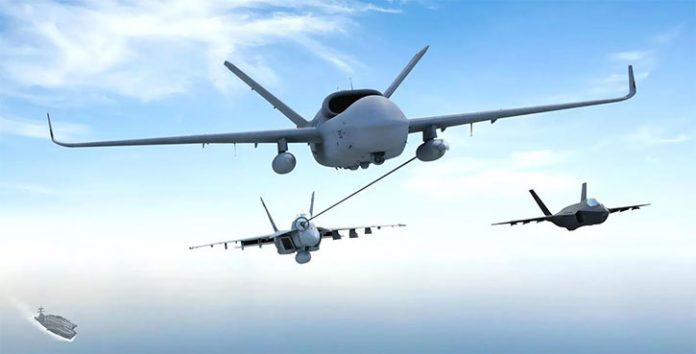
General Atomics Aeronautical Systems, Inc. (GA‑ASI) has formed an industry team to pursue the US Navy MQ-25 Stingray, the future carrier-based aerial refueling drone program. In addition to General Atomics acting as the team leader and system integrator and platform manufacturer and two sister companies in the GA group, the team includes Boeing, Pratt & Whitney, UTC, BAE Systems, L3, Rockwell Collins and GKN.
“GA-ASI has designed a purpose-built MQ-25A Stingray, optimized for the tanking mission and providing exceptional fuel give, that will more than double the range of the Carrier Air Wing. Our offering exceeds all of the Navy’s requirements, including carrier suitability.” David R. Alexander, president, GA-ASI said, adding “This collaboration of the best in the aerospace industry will provide the U.S. Navy with a fleet ready unmanned tanker with exceptional growth, well within the Navy’s preferred timeline.”
The most surprising member is the Autonomous Systems division of the Boeing Company. Boeing is also pursuing the MQ-25 opportunity with its own MQ-25 platform, developed by its rapid prototyping center – the ‘Phantom Works’. The recent announcement seems to put Boeing’s Autonomous Systems activity in competition with the parent company. “Boeing Autonomous Systems is pleased to have the opportunity to collaborate with General Atomics on its MQ-25 proposal,” said Vice President and General Manager Chris Raymond. “We look forward to supporting GA with our aviation and autonomous experience.”
The engine manufacturer will be Pratt & Whitney, that will provide the main propulsion system for the aircraft, to be based on its PW815 commercial turbofan engine; UTC Aerospace Systems, will design the drone’s landing gear, which will also include subsystems from GKN Aerospace’s Fokker business, specifically the tail hook for the MQ-25’s arresting gear system. L3 Technologies has also joined the team to provide communications systems for GA-ASI’s Stingray, along with Rockwell Collins that will provide a new generation of the TruNet ARC-210 networked communications airborne radio, advanced navigation technologies, and a comprehensive simulation framework to support General Atomics’ low-risk schedule. BAE Systems will be responsible for various software and cybersecurity capabilities.
Two General Atomics group companies, General Atomics Electromagnetic Systems (GAES), and GA Systems Integration have also joined the team providing up-front carrier integration experience and risk reduction, adding U.S. Navy program experience and landing gear integration expertise. The Electromagnetic Launch System (EMALS) developed by GAES began testing on the USS Ford at sea last year.











